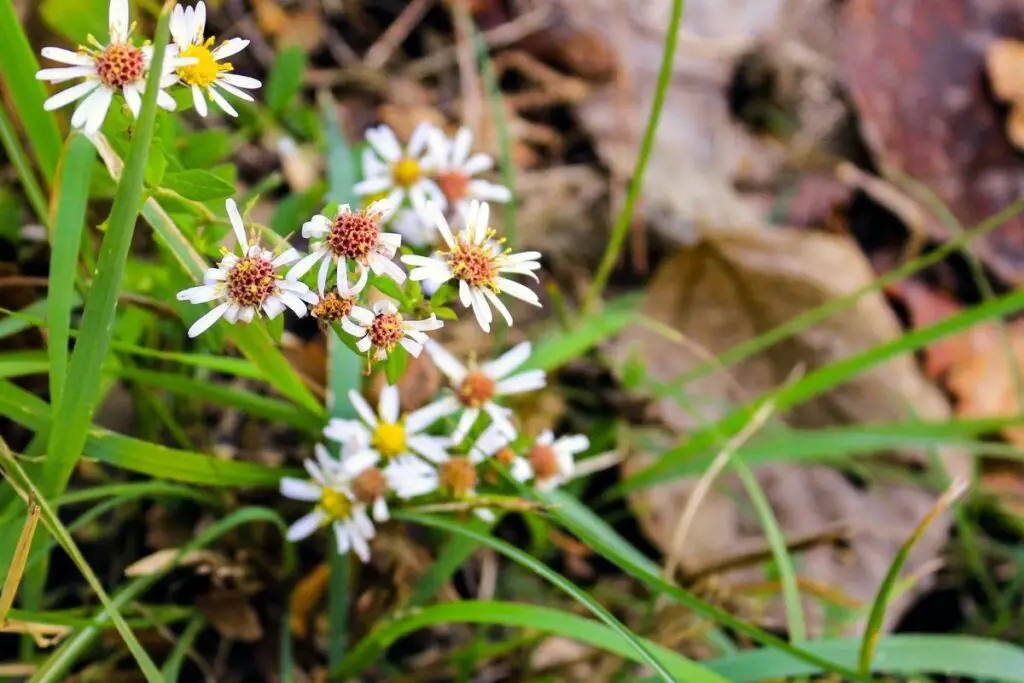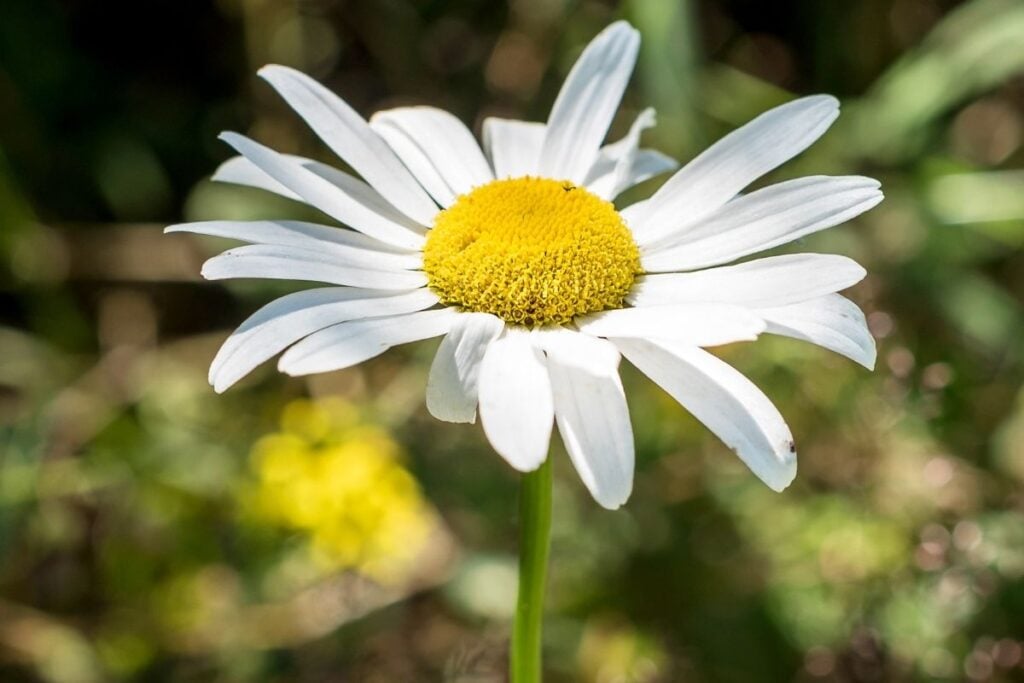Daisies (Bellis perennis) are sturdy sun-loving plants with beautiful blooms. If you have daisies in your garden, you know how wonderful they make your garden look. But sometimes the daisies might fall over, leaving a bald spot in the middle, and this will not be a very pleasing sight for your garden.
So, In this article, we will find out why are your daisies falling over and how to fix the same.
Lack of sunlight, heavy rain or improper watering, and inadequate fertilizer are primary problems due to which your daisies are falling over. Sometimes daisies can also lean if they are not sturdy enough to hold their upper stem or blooms. To fix the problem, fertilize and water them adequately.
There can be other reasons behind your daisies falling over. Let us discuss all these.

My Daisy is leaning
Let’s walk you through all the reasons due to which your daisy plants are leaning and discuss the points in detail.
Scarcity of sunlight
One of the main reasons for daisies falling over is a scarcity of sunlight.
If you have planted your daisies in such a spot where the sunlight is not proper, and your daisies are not getting six hours of direct sun, they might not grow as sturdy as they can, which can cause them to fall over.
To thrive and remain strong to hold their weight, daisies need a lot of sunlight throughout the day, so make sure your daisies are getting enough sunlight.
If your daisies are away from sunlight, they will automatically start leaning towards the source, making them bend and fall over.
Also read: How Much Light Do Daisies Need? (Daisy Light Requirements)
Heavy rain or improper watering
When sudden rainfall occurs after a bright and sunny day, it overwaters the plant. Wind along with rain can also disrupt the formation of the daisies. It can make daisies fall over or lean.
Overwatering can also cause root problems because the plant does not like to sit on the water. The roots of daisies need enough space to breathe, but if the drainage is not good enough, they will not transport the nutrients to the plant and start rotting due to excess moisture.
A lack of water can also cause problems for your daisies as they need a continuous supply of moisture while they are in the sun all day long. If not supplied with enough water, the plants can become dry and start falling over because of low energy levels.
Also read: How Much Water Do Daisies Need? (Daisy Water Requirements)
Looking for gardening supplies? We have tested 100's of products before recommending them to you guys. Check out our best pick below:
| Image | Gardening Supplies | Best Price? |
|---|---|---|
 Top
Top Top
Top | Raised Garden Bed Kit | Check On Amazon |
 | XLUX Soil Moisture Meter, Plant Water Monitor, Soil Hygrometer Sensor for Gardening, Farming, Indoor and Outdoor Plants, No Batteries Required | No Results |
 Top
Top Top
Top | 82 Pcs Garden Tools Set and Extra Succulent Tools Set | Check On Amazon |
 | Joeys Garden Expandable Garden Hose with 8 Function Hose Nozzle, Lightweight Anti-Kink Flexible Garden Hoses, Extra Strength Fabric with Double Latex Core, (50 FT, Black) | No Results |
 Top
Top Top
Top | Dual Chamber Compost Tumbler | Check On Amazon |
 Top
Top Top
Top | Sunnyglade Plant Stakes | Check On Amazon |
 Top
Top Top
Top | Organic Cold Pressed Neem Seed Oil | Check On Amazon |
 Top
Top Top
Top | Mighty Mint Gallon :-Insect and Pest Control Peppermint Oil | Check On Amazon |
 Top
Top Top
Top | Scotts DiseaseEx Lawn Fungicide | Check On Amazon |
 Top
Top Top
Top | Jacks Classic 20-20-20 All Purpose Fertilizer | Check On Amazon |
 Top
Top Top
Top | 30,000 Seeds Pollinator Attracting Wildflower Mixture | Check On Amazon |
 Top
Top Top
Top | Survival Vegetable Seeds Garden Kit-Over 16,000 Seeds | Check On Amazon |
Inadequate fertilizing
The daisies thrive quickly in favorable conditions and can use up all the nutrients from the soil over some time. Once the soil is exhausted and there are no nutrients left for the plant to use, the plant can show signs of weakness, and it will not grow at a regular pace.
You will need to supply your plant with fertilizer to make it flourish in the blooming season with beautiful blooms. But avoid overdoing it. Daisies will need fertilizer every six months if you are using granular fertilizer because it releases nutrients slowly in the soil for absorption.
If you use liquid fertilizer, you can feed your plants once or twice a month because it is diluted, due to which the absorption happens quickly.
Your plant can fall over or lean if you are over-fertilizing it. Over-fertilizing can increase the soil’s acidity and damage the roots, and the plants will not be able to draw the nutrients. It will make them fall over eventually.
If you are using an excess of compost or fertilizer, it will increase the soil’s nitrogen content, making your plant lush with squishy growth, which can lean over easily.
Also read: Do Daisies Need Fertilizer? (+Best Fertilizer Pick)
Shallow roots
If the clay content in your garden soil is heavy, it can impact the drainage for the plants. The roots cannot penetrate deep into the soil because there is not enough space for them.
The clay soil particles bind together firmly and do not leave enough space for the roots to penetrate deep enough. It can give birth to a shallow root system that is not strong enough to hold the plant together, and it leans over ultimately.
If your garden is clayey, you can add some sand and mulch to make it lighter and less dense so that the roots of your daisies can penetrate deep and hold themselves together with strong roots.
Also read: What Kind Of Soil Do Daisies Need? (Daisy Soil Requirements)
How to keep your daisies upright? (Solution)

If you want your daisies not to fall over you will need to take proper care of your plants and provide them with proper sunlight, water, and fertilizer. We will discuss each of these in detail.
Plant your daisies in a spot where it receives sunlight all day
Daisies being sun-loving, need to stay under the sun for most of the daytime only then they can grow stronger and thrive.
If they receive the proper amount of sunlight, they will grow more robust and healthy and not fall over.
If the plant is not placed under the sun directly, it will tend to lean over towards the sunlight.
Therefore, if you want to stop leaning, plant it directly under the sun, where it can get the maximum amount of sunlight.
You also need to ensure that the plant is not exposed to a scorching sun during summer, as it can lead to sunburn because the plant likes to stay in cool temperatures.
So, if possible, provide a temporary shed in the afternoon when the temperature is too hot for the plant. And also, spray some water to keep the moisture level intact during the hot summer afternoon.
Proper watering
If you are not aware of how much water your daisies need and you have planted them for the first time, you have to understand that daisies love to stay under the sun and require a good amount of moisture to thrive and bloom.
You need to be mindful that you are not overwatering or underwatering the plant. You will need to feed the plants with water at least once every five to six days.
Before watering the plants, you will also need to check if the soil still retains moisture by digging your finger inside the soil.
If the soil is dark, you don’t need to water until it becomes completely dry. Once you find that the soil has become dry and flaky, you can water your daisies slowly.
Avoid pouring a lot of water at a time. It will be good to use the drip irrigation process to water your daisies for a continuous supply of moisture under the sun.
Adequate fertilization
You surely want your daisies to thrive and grow strong so that they don’t lean. You will need to supply your plants will proper nutrients to keep them healthy and strong.
Daisies will need all-purpose fertilizer with a 10:10:10 NPK ratio. You can fertilize your daisies after 15 to 30 days after you have planted them.
Once they have used up all the fertilizer from the soil, you will need to fertilize again. The frequency depends on what kind of fertilizer you are using.
How frequently do I fertilize my daisies?

If you use granular fertilizer, you will need to fertilize the plant every five to six months because these fertilizers release nutrients slowly into the soil.
But if you are using diluted liquid fertilizer, you can fertilize your plants every month because this fertilizer can be absorbed quickly by the plant.
Before the blooming season, you need to fertilize your plant with 10:16:10 fertilizer as the plant will need more potassium for showy blooms.
During the winters, the daisies remain dormant, and they will not require fertilizer at that time. So do not over-fertilize them and let them grow at their own pace during winters.
Dividing your daisies
In every two to three years, the bush of the daisies can show bold patches in the middle and can fall over from outside. This is the time when you know you should divide your daisies.
In the autumn season, you should divide your daisies when the plant is no longer blooming. Dividing your daisies will help them grow faster.
You will need to prepare the soil where you want to plant it before you divide it.
You will need to dig the ground eight to ten inches deep. You will also need to dig in three to six inches of organic material like peat moss or compost along with granular fertilizer.
To divide the daisies, dig the ground six to eight inches deep with a shovel from the center of the plant. Dig deep to avoid any damage to the roots, and then push the shovel back and forth so that the roots get loosened.
Continue digging around the circumference of the plant, and when you are done with digging, carefully lift the daisies from the ground.
You can divide the daisies by pulling them apart from the clump and then make holes wide enough to plant them so that the roots can be appropriately accommodated. Don’t plant them too deep as it can kill the plant.
Add soil where you have planted your daisies and pat them gently to remove air bubbles but don’t press too much on the soil. You can also spread two to three inches of mulch to retain some moisture.
Final words
Once your daisies are fully grown, and they also have blooms, they tend to lean over if they don’t have enough strength to hold their weight. In this case, you will need to trim and prune them. You will need to cut the dead heads of the plant and take off the extra weight that they are carrying.
Trimming the deadheads and dead stems will boost the plant’s growth hormone and make it grow stronger. You also need to ensure they’re getting enough sunlight to carry out photosynthesis for their growth and nutrition.
When daisies receive heavy rain after a dry spell, they can often lean over due to this reason. To avoid this, you will need to plant your daisies in the soil where the sand content and the drainage are excellent. It will give enough space for the roots to dig deep and hold the plants in their place.
Ref: Wikipedia, Britannica, University Of Florida, Ucanr.edu
